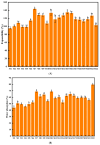Analysis of Comprehensive Edible Quality and Volatile Components in Different Varieties of Cooked Highland Barley
- PMID: 40428470
- PMCID: PMC12110760
- DOI: 10.3390/foods14101690
Analysis of Comprehensive Edible Quality and Volatile Components in Different Varieties of Cooked Highland Barley
Abstract
Twenty-two types of highland barley (HB) raw materials (including 10 common varieties and 5 main planting regions in the Qinghai province) were selected as the experimental materials to investigate their differences in the cooking characteristics, sensory quality, and characteristic flavor of cooked HB. The key volatile flavor components were identified using Gas Chromatography-Ion Mobility Spectroscopy (GC-IMS) combined with relative odor activity value (ROAV) analysis. The results indicated that the highland barley raw materials of Kunlun 15 (M5), Kunlun 14 (M9), Chaiqing 1 (M13) and Kunlun 14 (M14), and Chaiqing 1 (M20) and Kunlun 15 (M21) showed superior cooking quality, texture, and sensory scores. A total of 44 volatile flavor compounds were identified, including 16 aldehydes, 10 alcohols, 9 ketones, 7 esters, 1 acid, and 1 furan. Among these, 13 aldehydes, 4 alcohols, 4 ketones, 7 esters, and 1 furan were found across different cooked HB samples. Notably, ethyl, ethyl 2-methylbutanoate dimer, 2-methylbutanoic acid methyl ester, 2-butanone, 1-octen-3-ol, 1-pentanol dimer, and 2-pentyl furan contributed more significantly to the overall volatile profile. Cluster analysis combining principal component analysis revealed that Kunlun 16 (M16), Kunlun 17 (M17), Kunlun 14 (M18), Kunlun 15 (M19), as well as Chaiqing 1 (M20) and Kunlun 15 (M21), were the most suitable raw materials for cooking due to their better cooking quality, sensory attributes, and flavors, followed by Kunlun 15 (M10) and Kunlun 18 (M12), and Chaiqing 1 (M13) and Kunlun 14 (M14). These findings could help us identify specific HB varieties in corresponding regions with advantages, thus providing a theoretical basis for cooking HB.
Keywords: GC-IMS; comprehensive edible quality; highland barley; volatile flavor.
Conflict of interest statement
The authors declare no conflicts of interest.
Figures





Similar articles
-
Comparative Analysis of Texture Characteristics, Sensory Properties, and Volatile Components in Four Types of Marinated Tofu.Foods. 2024 Jun 29;13(13):2068. doi: 10.3390/foods13132068. Foods. 2024. PMID: 38998575 Free PMC article.
-
Analysis of volatile compounds and flavor fingerprint in Jingyuan lamb of different ages using gas chromatography-ion mobility spectrometry (GC-IMS).Meat Sci. 2021 May;175:108449. doi: 10.1016/j.meatsci.2021.108449. Epub 2021 Jan 23. Meat Sci. 2021. PMID: 33550158
-
Characterization and discrimination of flavor volatiles of different colored wheat grains after cooking based on GC-IMS and chemometrics.Curr Res Food Sci. 2023 Aug 30;7:100583. doi: 10.1016/j.crfs.2023.100583. eCollection 2023. Curr Res Food Sci. 2023. PMID: 37691695 Free PMC article.
-
Development of a Flavor Fingerprint Using HS-GC-IMS for Volatile Compounds from Steamed Potatoes of Different Varieties.Foods. 2023 Jun 2;12(11):2252. doi: 10.3390/foods12112252. Foods. 2023. PMID: 37297496 Free PMC article.
-
Comprehensive review of sweetpotato flavor compounds: Opportunities for developing consumer-preferred varieties.Compr Rev Food Sci Food Saf. 2025 May;24(3):e70172. doi: 10.1111/1541-4337.70172. Compr Rev Food Sci Food Saf. 2025. PMID: 40271721 Free PMC article. Review.
References
-
- Holtekjolen A.K., Uhlen A.K., Bråthen E., Sahlstrom S., Knutsen S.H. Contents of starch and non-starch polysaccharides in barley varieties of different origin. Food Chem. 2006;94:348–358. doi: 10.1016/j.foodchem.2004.11.022. - DOI
-
- Zong Y., Tian S.Q., Zhang Y., Liu Z.X., Chen Z.C. Effects of highland barley powders with different peeling rates on the rheological properties of dough and sensory, volatile flavor evaluation of bread. J. Food Process. Preserv. 2022;46:e16971. doi: 10.1111/jfpp.16971. - DOI
-
- Li J., Zhang X., Zhou W.J., Tu Z.X., Yang S., Xia T.L., Chen Z.X., Du Y. Intelligent films based on highland barley β-glucan/highland barley prolamin incorporated with black rice bran anthocyanins. Food Packag. Shelf Life. 2023;39:101146. doi: 10.1016/j.fpsl.2023.101146. - DOI
Grants and funding
LinkOut - more resources
Full Text Sources
Miscellaneous

